engine PONTIAC G6 2007 User Guide
[x] Cancel search | Manufacturer: PONTIAC, Model Year: 2007, Model line: G6, Model: PONTIAC G6 2007Pages: 486, PDF Size: 2.78 MB
Page 122 of 486

Starting and Operating Your
Vehicle
New Vehicle Break-In
Notice:Your vehicle does not need an
elaborate break-in. But it will perform better in
the long run if you follow these guidelines:
Do not drive at any one constant speed, fast
or slow, for the �rst 500 miles (805 km). Do
not make full-throttle starts. Do not exceed
5,000 engine rpm. Avoid downshifting to
brake, or slow, the vehicle.
Avoid making hard stops for the �rst
200 miles (322 km) or so. During this time
your new brake linings are not yet broken
in. Hard stops with new linings can mean
premature wear and earlier replacement.
Follow this breaking-in guideline every time
you get new brake linings.
Do not tow a trailer during break-in. See
Towing a Trailer on page 296for the trailer
towing capabilities of your vehicle and more
information.Following break-in, engine speed and load can
be gradually increased.
Ignition Positions
With the key in the
ignition switch, you can
turn it to four different
positions.
Notice:Using a tool to force the key from the
ignition switch could cause damage or break
the key. Use the correct key and turn the key
only with your hand. Make sure the key is in all
the way. If none of this works, then your vehicle
needs service.
122
Page 123 of 486
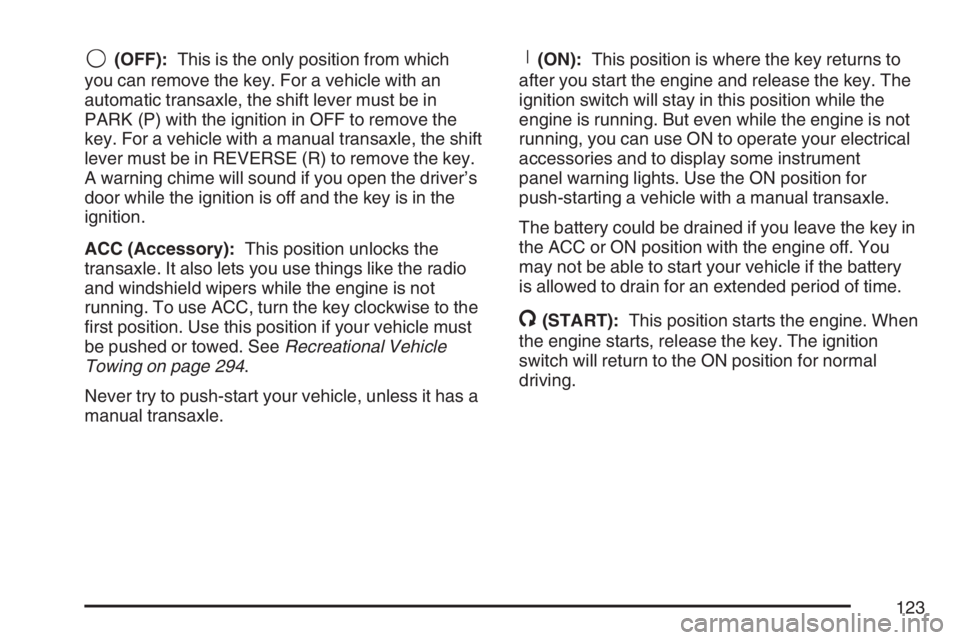
9(OFF):This is the only position from which
you can remove the key. For a vehicle with an
automatic transaxle, the shift lever must be in
PARK (P) with the ignition in OFF to remove the
key. For a vehicle with a manual transaxle, the shift
lever must be in REVERSE (R) to remove the key.
A warning chime will sound if you open the driver’s
door while the ignition is off and the key is in the
ignition.
ACC (Accessory):This position unlocks the
transaxle. It also lets you use things like the radio
and windshield wipers while the engine is not
running. To use ACC, turn the key clockwise to the
�rst position. Use this position if your vehicle must
be pushed or towed. SeeRecreational Vehicle
Towing on page 294.
Never try to push-start your vehicle, unless it has a
manual transaxle.R(ON):This position is where the key returns to
after you start the engine and release the key. The
ignition switch will stay in this position while the
engine is running. But even while the engine is not
running, you can use ON to operate your electrical
accessories and to display some instrument
panel warning lights. Use the ON position for
push-starting a vehicle with a manual transaxle.
The battery could be drained if you leave the key in
the ACC or ON position with the engine off. You
may not be able to start your vehicle if the battery
is allowed to drain for an extended period of time.
/(START):This position starts the engine. When
the engine starts, release the key. The ignition
switch will return to the ON position for normal
driving.
123
Page 125 of 486
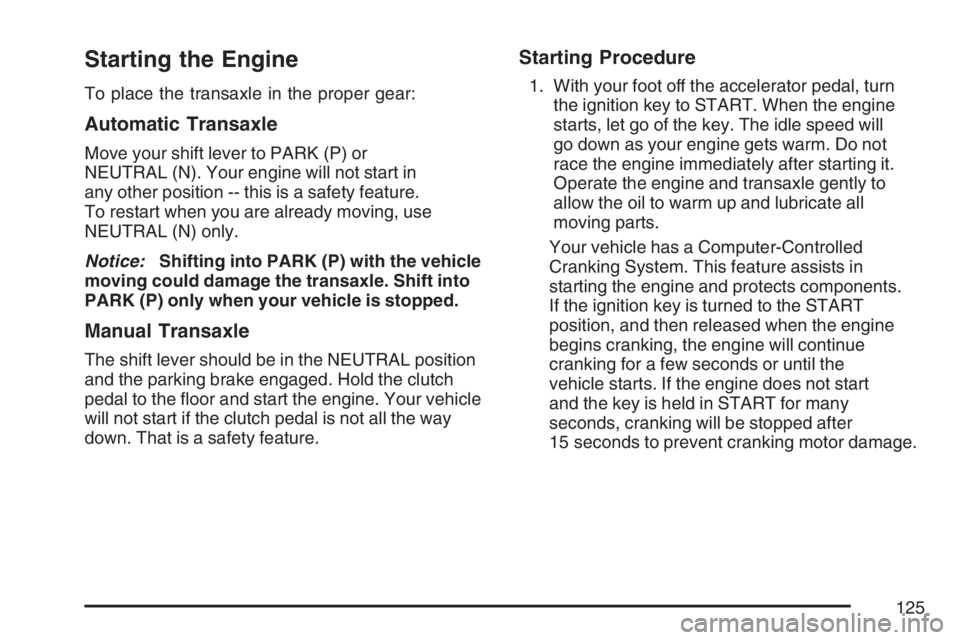
Starting the Engine
To place the transaxle in the proper gear:
Automatic Transaxle
Move your shift lever to PARK (P) or
NEUTRAL (N). Your engine will not start in
any other position -- this is a safety feature.
To restart when you are already moving, use
NEUTRAL (N) only.
Notice:Shifting into PARK (P) with the vehicle
moving could damage the transaxle. Shift into
PARK (P) only when your vehicle is stopped.
Manual Transaxle
The shift lever should be in the NEUTRAL position
and the parking brake engaged. Hold the clutch
pedal to the �oor and start the engine. Your vehicle
will not start if the clutch pedal is not all the way
down. That is a safety feature.
Starting Procedure
1. With your foot off the accelerator pedal, turn
the ignition key to START. When the engine
starts, let go of the key. The idle speed will
go down as your engine gets warm. Do not
race the engine immediately after starting it.
Operate the engine and transaxle gently to
allow the oil to warm up and lubricate all
moving parts.
Your vehicle has a Computer-Controlled
Cranking System. This feature assists in
starting the engine and protects components.
If the ignition key is turned to the START
position, and then released when the engine
begins cranking, the engine will continue
cranking for a few seconds or until the
vehicle starts. If the engine does not start
and the key is held in START for many
seconds, cranking will be stopped after
15 seconds to prevent cranking motor damage.
125
Page 126 of 486
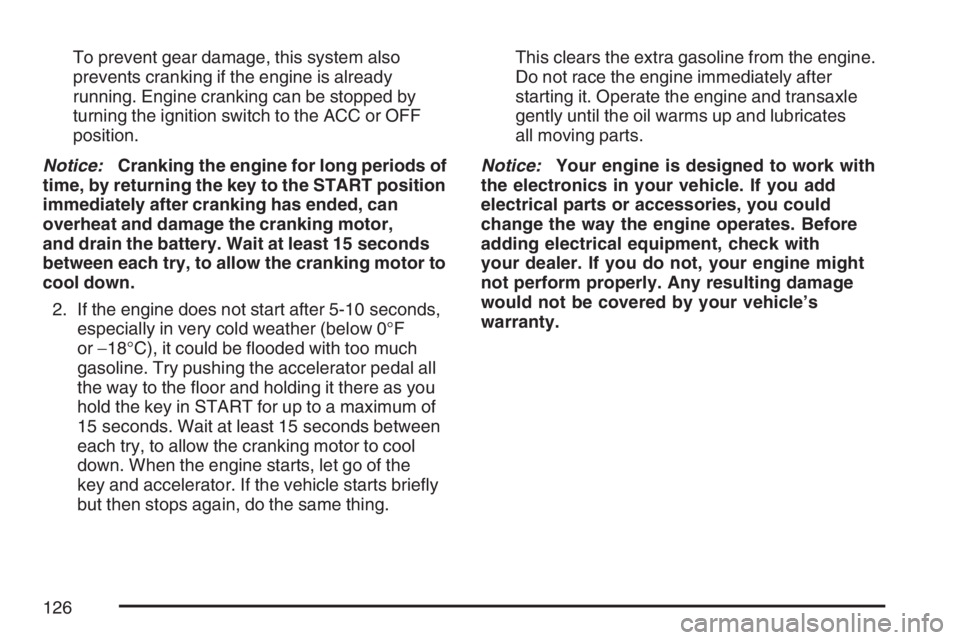
To prevent gear damage, this system also
prevents cranking if the engine is already
running. Engine cranking can be stopped by
turning the ignition switch to the ACC or OFF
position.
Notice:Cranking the engine for long periods of
time, by returning the key to the START position
immediately after cranking has ended, can
overheat and damage the cranking motor,
and drain the battery. Wait at least 15 seconds
between each try, to allow the cranking motor to
cool down.
2. If the engine does not start after 5-10 seconds,
especially in very cold weather (below 0°F
or−18°C), it could be �ooded with too much
gasoline. Try pushing the accelerator pedal all
the way to the �oor and holding it there as you
hold the key in START for up to a maximum of
15 seconds. Wait at least 15 seconds between
each try, to allow the cranking motor to cool
down. When the engine starts, let go of the
key and accelerator. If the vehicle starts brie�y
but then stops again, do the same thing.This clears the extra gasoline from the engine.
Do not race the engine immediately after
starting it. Operate the engine and transaxle
gently until the oil warms up and lubricates
all moving parts.
Notice:Your engine is designed to work with
the electronics in your vehicle. If you add
electrical parts or accessories, you could
change the way the engine operates. Before
adding electrical equipment, check with
your dealer. If you do not, your engine might
not perform properly. Any resulting damage
would not be covered by your vehicle’s
warranty.
126
Page 128 of 486

Engine Coolant Heater
Your vehicle may have this feature. In very cold
weather, 0°F (−18°C) or colder, the engine coolant
heater can provide easier starting and better fuel
economy during engine warm-up. Usually, the
coolant heater should be plugged in a minimum
of four hours prior to starting your vehicle. At
temperatures above 32°F (0°C), use of the coolant
heater is not required. Your vehicle may also have
an internal thermostat in the plug end of the cord.
This will prevent operation of the engine coolant
heater when the temperature is at or above
0°F (−18°C) as noted on the cord.
To Use the Engine Coolant Heater
1. Turn off the engine.
2. Open the hood and unwrap the electrical cord.
On the 2.4L L4 ECOTEC
®engine, the engine
coolant heater cord is located near the air
cleaner box on the passenger’s side of the
engine compartment. On the 3.5L, 3.6L and
3.9L V6 engines, the engine coolant heater
cord is located on the driver’s side around
the battery box. SeeEngine Compartment
Overview on page 318for more information
on location.3. Plug the cord into a normal, grounded
110-volt AC outlet.
{CAUTION:
Plugging the cord into an ungrounded
outlet could cause an electrical shock.
Also, the wrong kind of extension cord
could overheat and cause a �re. You
could be seriously injured. Plug the cord
into a properly grounded three-prong
110-volt AC outlet. If the cord will not
reach, use a heavy-duty three-prong
extension cord rated for at least 15 amps.
4. Before starting the engine, be sure to unplug
and store the cord as it was before to keep it
away from moving engine parts. If you do
not, it could be damaged.
How long should you keep the coolant
heater plugged in? The answer depends
on the outside temperature, the kind
of oil you have, and some other things.
128
Page 129 of 486
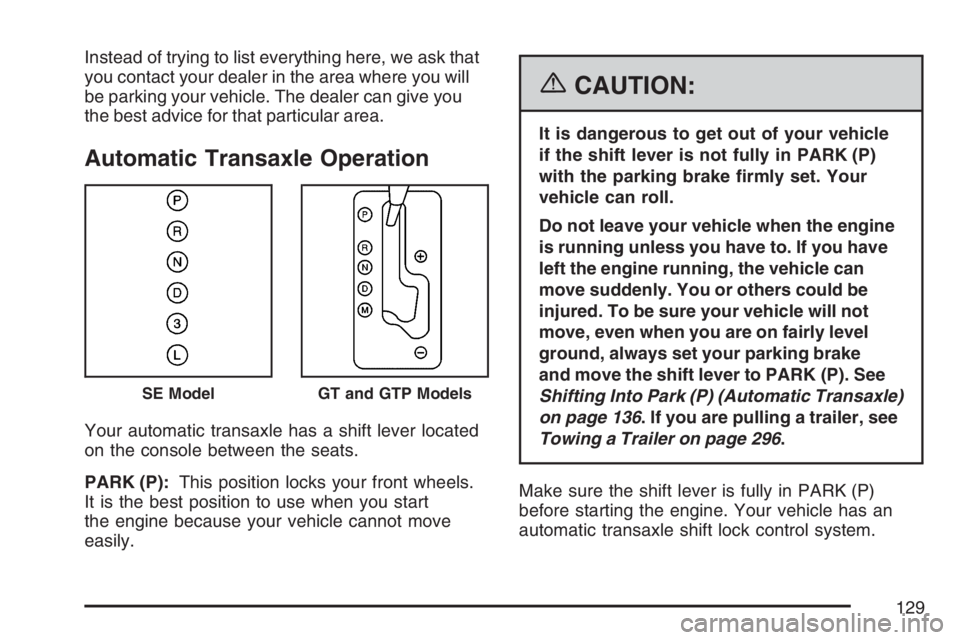
Instead of trying to list everything here, we ask that
you contact your dealer in the area where you will
be parking your vehicle. The dealer can give you
the best advice for that particular area.
Automatic Transaxle Operation
Your automatic transaxle has a shift lever located
on the console between the seats.
PARK (P):This position locks your front wheels.
It is the best position to use when you start
the engine because your vehicle cannot move
easily.
{CAUTION:
It is dangerous to get out of your vehicle
if the shift lever is not fully in PARK (P)
with the parking brake �rmly set. Your
vehicle can roll.
Do not leave your vehicle when the engine
is running unless you have to. If you have
left the engine running, the vehicle can
move suddenly. You or others could be
injured. To be sure your vehicle will not
move, even when you are on fairly level
ground, always set your parking brake
and move the shift lever to PARK (P). See
Shifting Into Park (P) (Automatic Transaxle)
on page 136. If you are pulling a trailer, see
Towing a Trailer on page 296.
Make sure the shift lever is fully in PARK (P)
before starting the engine. Your vehicle has an
automatic transaxle shift lock control system.
SE ModelGT and GTP Models
129
Page 130 of 486

You have to apply your regular brake �rst and then
press the shift lever button before you can shift from
PARK (P) while the ignition key is in ON. If you
cannot shift out of PARK (P), ease pressure on the
shift lever and push the shift lever all the way into
PARK (P) as you maintain brake application. Press
the shift lever button and then move the shift lever
into another gear. SeeShifting Out of Park (P)
(Automatic Transaxle) on page 138later in this
section.
REVERSE (R):Use this gear to back up.
Notice:Shifting to REVERSE (R) while your
vehicle is moving forward could damage the
transaxle. The repairs would not be covered by
your warranty. Shift to REVERSE (R) only after
your vehicle is stopped.
To rock your vehicle back and forth to get out of
snow, ice, or sand without damaging your
transaxle, seeIf Your Vehicle is Stuck in Sand,
Mud, Ice, or Snow on page 287.NEUTRAL (N):In this position, your engine does
not connect with the wheels. To restart when
you are already moving, use NEUTRAL (N) only.
Also, use NEUTRAL (N) when your vehicle is
being towed.
{CAUTION:
Shifting into a drive gear while your
engine is running at high speed is
dangerous. Unless your foot is �rmly on
the brake pedal, your vehicle could move
very rapidly. You could lose control and
hit people or objects. Do not shift into a
drive gear while your engine is running at
high speed.
Notice:Shifting out of PARK (P) or
NEUTRAL (N) while the engine is running at
high speed may damage the transaxle. The
repairs would not be covered by your warranty.
Be sure the engine is not running at high
speeds when shifting your vehicle.
130
Page 132 of 486
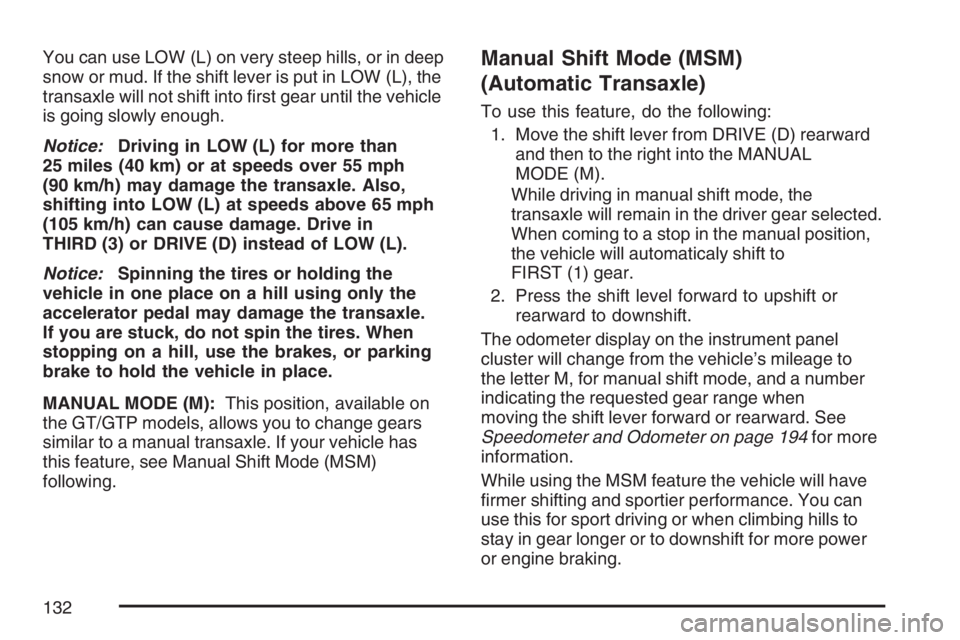
You can use LOW (L) on very steep hills, or in deep
snow or mud. If the shift lever is put in LOW (L), the
transaxle will not shift into �rst gear until the vehicle
is going slowly enough.
Notice:Driving in LOW (L) for more than
25 miles (40 km) or at speeds over 55 mph
(90 km/h) may damage the transaxle. Also,
shifting into LOW (L) at speeds above 65 mph
(105 km/h) can cause damage. Drive in
THIRD (3) or DRIVE (D) instead of LOW (L).
Notice:Spinning the tires or holding the
vehicle in one place on a hill using only the
accelerator pedal may damage the transaxle.
If you are stuck, do not spin the tires. When
stopping on a hill, use the brakes, or parking
brake to hold the vehicle in place.
MANUAL MODE (M):This position, available on
the GT/GTP models, allows you to change gears
similar to a manual transaxle. If your vehicle has
this feature, see Manual Shift Mode (MSM)
following.Manual Shift Mode (MSM)
(Automatic Transaxle)
To use this feature, do the following:
1. Move the shift lever from DRIVE (D) rearward
and then to the right into the MANUAL
MODE (M).
While driving in manual shift mode, the
transaxle will remain in the driver gear selected.
When coming to a stop in the manual position,
the vehicle will automaticaly shift to
FIRST (1) gear.
2. Press the shift level forward to upshift or
rearward to downshift.
The odometer display on the instrument panel
cluster will change from the vehicle’s mileage to
the letter M, for manual shift mode, and a number
indicating the requested gear range when
moving the shift lever forward or rearward. See
Speedometer and Odometer on page 194for more
information.
While using the MSM feature the vehicle will have
�rmer shifting and sportier performance. You can
use this for sport driving or when climbing hills to
stay in gear longer or to downshift for more power
or engine braking.
132
Page 133 of 486

The transaxle will only allow you to shift into gears
appropriate for the vehicle speed and engine
revolutions per minute (RPM):
The transaxle will not automatically shift to the
next higher gear if the engine RPM is too high.
The transaxle will not allow shifting to the next
lower gear if the engine RPM is too high.
If the vehicle does not respond to a gear change, or
detects a problem with the transaxle, the range of
gears may be reduced and the Malfunction
Indicator Lamp will come on. SeeMalfunction
Indicator Lamp on page 204for more information.
SECOND (2)/THIRD (3)
Gear Start Feature
Notice:If you attempt a third gear start while
trailering or towing a heavy load, you will notice
reduced engine power. This could overheat and
damage your transaxle. Do not attempt a third
gear start while trailering or towing your
vehicle.If your vehicle has the 6-speed transaxle, when
accelerating your vehicle from a stop in snowy
and icy conditions, you may want to shift into
SECOND (2), or THIRD (3) gear. A higher gear,
and light application of the gas pedal, may allow
you to gain more traction on slippery surfaces.
With the TAP-Shift feature, the vehicle can
accelerate from a stop in SECOND (2) or
THIRD (3).
1. Move the shift lever from DRIVE (D) into the
MANUAL MODE (M) position.
2. With the vehicle stopped, press the plus (+)
paddle forward to select SECOND (2) or
THIRD (3)gear. The vehicle will start
from a stop position in SECOND (2) or
THIRD (3)gear.
3. Once the vehicle is moving select the desired
drive gear.
133
Page 134 of 486

Manual Transaxle Operation
This is your shift pattern.
The clutch must be fully
pressed in when shifting
a manual transaxle to
ensure the transaxle is
fully in gear.
Here is how to operate your transaxle:
FIRST (1):Press the clutch pedal and shift into
FIRST (1). Then, slowly let up on the clutch pedal
as you press the accelerator pedal.
You can shift into FIRST (1) when you are going
less that 20 mph (32 km/h). If you have come to a
complete stop and it is hard to shift into FIRST (1),
put the shift lever into NEUTRAL and let up on the
clutch. Press the clutch pedal back down. Then shift
into FIRST (1).SECOND (2):Press the clutch pedal as
you let up on the accelerator pedal and shift into
SECOND (2). Then, slowly let up on the clutch
pedal as you press the accelerator pedal.
THIRD (3), FOURTH (4), and FIFTH (5) and
SIXTH (6):Shift into THIRD (3), FOURTH (4) and
FIFTH (5) and SIXTH (6) the same way you do
for SECOND (2). Slowly let up on the clutch pedal
as you press the accelerator pedal.
To stop, let up on the accelerator pedal and press
the brake pedal. Just before the vehicle stops,
press the clutch pedal and the brake pedal,
and shift to Neutral.
NEUTRAL:Use this position when you start or
idle your engine.
REVERSE (R):To back up, press down the
clutch pedal and lift up on the ring on the shift lever
to shift into REVERSE (R). Let up on the clutch
pedal slowly while pressing the accelerator pedal.
Notice:Shifting to REVERSE (R) while your
vehicle is moving forward could damage the
transaxle. The repairs would not be covered by
your warranty. Shift to REVERSE (R) only after
your vehicle is stopped.
134